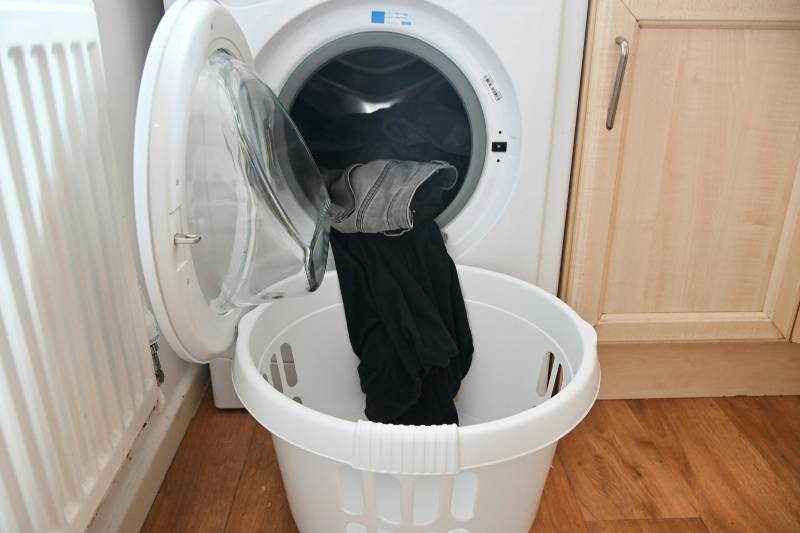You finally get to the last load of laundry, and just as you’re putting the clean clothes into the dryer, you see some odd spots that weren’t there earlier.
They’re not the typical stains you’re used to handling, these are blue or white and look suspiciously like your laundry detergent.
How did they get there, and more importantly, how can you remove them? As frustrating as this discovery may be, don’t worry, there are effective solutions to get your clothes looking spotless again.
What Kinds of Laundry Detergent Will Stain Your Clothes and How Does It Look Like?
When it comes to laundry detergent, the two common culprits that can leave marks on your clothes are liquid and powder detergents.
Liquid detergent stains typically appear as blue or dark blobs that smudge when touched. They can happen if you pour detergent directly onto your clothes or if the washing machine doesn’t rinse thoroughly.
Powder detergent, on the other hand, can leave behind a white, chalky residue that feels stiff and is hard to brush off. These issues often crop up when too much detergent is used, it’s not properly dissolved, or when washing in cold water that doesn’t effectively dissolve the powder.
Why Does Laundry Detergent Stain Clothes?
You might think laundry detergent’s sole mission is to clean, but under certain circumstances, it can leave its own stains.
But why? Well, laundry detergent stains can occur for various reasons.
Using too much detergent can lead to an excess that the washer can’t rinse away entirely. Water temperature plays a role too, as cold water might not dissolve the detergent effectively, especially if it’s powder form.
Plus, pouring detergent directly onto the fabric can trap the soap between the garment and the washer drum or other clothes, leading to stains.
Sometimes, a malfunctioning washing machine with poor rinsing action leaves detergent trapped in fabrics.
To keep your favorite garments stain-free, understanding what causes these marks is the first step in addressing and preventing them.
Ways To Get Laundry Detergent Stains Out Of Clothes
When you’re facing laundry detergent stains, you don’t have to deem your clothes ruined. Several household items can come to your rescue, and the tricks to use them are simple enough for anyone to manage.
Let’s see how you can get those stains out using items you probably already have in your home.
1. Baking Soda
Baking soda isn’t just for baking; it’s a star in cleaning detergent stains.
Mix it into a paste with a bit of water, apply it directly onto the stain, and gently rub it in. Let it sit for a few minutes for light stains or a couple of hours for more stubborn marks.
The baking soda will lift the detergent out of the fabric. After treating the area, wash the garment in the warmest water safe for the fabric. Check if the stain is gone before drying, as heat can set it permanently.
2. Rubbing Alcohol
Rubbing alcohol is another brilliant stain remover. Dab a little onto a cotton ball or cloth and blot the stained area. Don’t rub too harshly, as this could spread the detergent further into the fibers.
After you’ve loosened the detergent stain, rinse the area with warm water, and then proceed with a regular wash. Keep your laundry room ventilated when using rubbing alcohol.
3. Vinegar
Vinegar, particularly white vinegar, is great for tackling laundry detergent stains. Mix one part white vinegar with two parts water and presoak the stain.
Vinegar acts as a solvent, helping to dissolve the detergent residue. After soaking for 15 to 30 minutes, give the area a gentle rub, then wash as usual.
If the stain persists, you can apply the vinegar solution directly to the spot before laundering. As an added bonus, vinegar can also work as a fabric softener, making your clothes feel soft and smell fresh.
4. Dish Soap
Dish soap is formulated to cut through grease and grime, which makes it effective for removing laundry detergent stains as well.
Apply a small amount of liquid dish soap to the stained area and gently massage it in with your fingers or a soft brush. Allow it to sit for a few minutes to break down the detergent, then rinse thoroughly with warm water.
Wash the clothing item as normal and the stain should come right out.
5. Bar Soap
Bar soap can be used in much the same way as dish soap when it comes to laundry detergent stains.
Wet a bar of white soap and rub it directly onto the stain. Work it in to create a lather, which will help lift the detergent out of the fabric fibers. Rinse the area with warm water and then launder the garment, checking to ensure the stain is gone before drying.
6. Agitation
Sometimes simple agitation can release the detergent trapped in the fabric. You can rub the fabric against itself, or use a soft-bristled brush to gently work out the stain. After a bit of physical working, rinse the item in warm water.
If you see the stain lightening, it’s a good sign! Continue the process and then launder the clothing item with other garments. Just ensure not to be too rigorous with delicate fabrics that could get damaged with excessive agitation.
7. Pre-Treat With a Commercial Stain Remover
As much as home remedies work, sometimes a store-bought stain remover is the quickest path to success.
Opt for one that’s formulated to treat laundry detergent or soap scum. Follow the instructions on the product label, which typically involve applying the stain remover directly to the mark, letting it sit for a specified amount of time, and then washing the garment as usual.
8. Lemon Juice
Lemon juice has natural bleaching properties that can help to remove laundry detergent stains from light-colored or white clothing.
Squeeze fresh lemon juice onto the stain and let it sit in the sun for an hour or so—the sun’s UV rays will help increase the lemon juice’s efficacy. Then, give the garment a regular wash and check for residue before drying.
How To Avoid Detergent Stains Further?
Prevention is always better than cure, and this rings true when it comes to laundry too. After getting rid of those pesky detergent stains, you’ll want to make sure they don’t happen again. A few changes to your laundry routine can make all the difference in preventing future stains.
Use the Right Amount of Detergent
Always measure your laundry detergent according to the package instructions and the size of your laundry load. Too much detergent can leave residue on clothes, which can then lead to stains.
Add Detergent Before Clothes
To ensure your detergent fully dissolves, add it to the washing machine drum before loading your clothes. This gives the detergent a chance to mix with the water and spread evenly, reducing the risk of concentrated detergent coming in direct contact with your garments.
Check Water Temperature
Different detergents have optimal water temperatures in which they dissolve best. Make sure to use the correct temperature setting for the detergent you are using. Warmer water can be more effective for powders, while cooler temperatures are suitable for certain liquid detergents designed for cold-water washing.
Clean Your Washing Machine Regularly
The buildup of detergent and fabric softener can cause your washing machine to function less effectively over time. Regular maintenance cleans will help ensure that it rinses thoroughly. Once a month, run an empty hot water cycle with a washing machine cleaner or distilled white vinegar.
Opt for Liquid Detergent
If stains persist and you’re using powder detergent, consider switching to liquid, which tends to dissolve more easily. This can be particularly helpful if you live in an area with hard water that can hinder the dissolution of powdered detergents.
Be Careful with Detergent Pods
Detergent pods are convenient, but they need to be placed at the bottom of the drum before adding clothes. This way, there’s less chance of the pod not fully dissolving and leaving a gelatinous stain on your fabric.
Moreover, ensure the pod is suited to the load size; some pods are made to handle larger loads than others.
Pre-Dissolve Powder Detergent
If you’re using powder detergent, consider pre-dissolving it in a little water before adding it to the washing machine. This can help prevent undissolved powder from clinging to your clothes.
Avoid Overloading the Washer
An overloaded washing machine doesn’t clean as effectively. Clothes need room to move freely to be thoroughly rinsed. If they can’t circulate properly, detergent might remain trapped in the clothing.
Sort Clothes Properly
It’s not just about colors and whites—sorting clothes by fabric type and soil level can also prevent stains. Heavily soiled clothes might need more detergent or a stronger wash cycle, which could affect other, less dirty items.
Read Fabric Care Labels
Fabrics have different needs, and the care labels are there to help. Paying attention to the washing instructions can prevent mishaps, including the need to use special detergent types or different wash settings.
Conclusion
With these methods mentioned in the article, hope you can remove those laundry detergent stains and prevent them from happening again.





